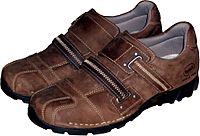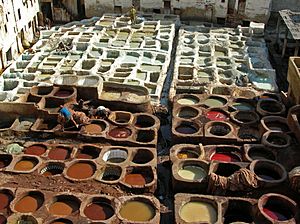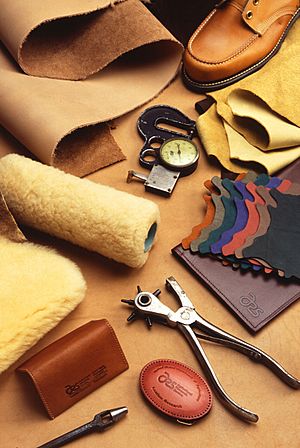Leather facts for kids
Leather is the skin of an animal used as a material. The skins of cows, pigs, and goats are often used to make leather. Skins of snakes, alligators or crocodiles, and ostriches are sometimes used to make fancier leather. Shoes, bags, clothes, and balls are often made of leather.
Production processes
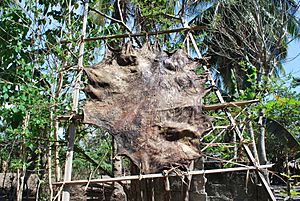
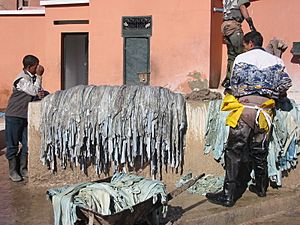
The leather manufacturing process is divided into three fundamental subprocesses: preparatory stages, tanning, and crusting. A further subprocess, surface coating, can be added into the leather process sequence, but not all leathers receive surface treatment.
The preparatory stages are when the hide is prepared for tanning. Preparatory stages may include: liming, deliming, hair removal, degreasing, bleaching, and pickling.
Tanning is a process that stabilizes the proteins of the raw hide so it does not putrefy, making it suitable for a wide variety of end applications. The principal difference between raw and tanned hides is that raw hides dry out to form a hard, inflexible material that, when rewetted, will putrefy, while tanned material dries to a flexible form that does not become putrid when rewetted.
Many tanning methods and materials exist. The typical process sees tanners load the hides into a drum and immerse them in a tank that contains the tanning "liquor". The hides soak while the drum slowly rotates about its axis, and the tanning liquor slowly penetrates through the full thickness of the hide. Once the process achieves even penetration, workers slowly raise the liquor's pH in a process called basification, which fixes the tanning material to the leather. The more tanning material fixed, the higher the leather's hydrothermal stability and shrinkage temperature resistance.
Crusting is a process that thins and lubricates leather. It often includes a coloring operation. Chemicals added during crusting must be fixed in place. Crusting culminates with a drying and softening operation, and may include splitting, shaving, dyeing, whitening or other methods.
For some leathers, tanners apply a surface coating, called "finishing". Finishing operations can include oiling, brushing, buffing, coating, polishing, embossing, glazing, or tumbling, among others.
Leather can be oiled to improve its water resistance. This currying process after tanning supplements the natural oils remaining in the leather itself, which can be washed out through repeated exposure to water. Frequent oiling of leather, with mink oil, neatsfoot oil, or a similar material keeps it supple and improves its lifespan dramatically.
Tanning methods
Tanning processes largely differ in which chemicals are used in the tanning liquor. Some common types include:
- Vegetable-tanned leather is tanned using tannins extracted from vegetable matter, such as tree bark prepared in bark mills. It is the oldest known method. It is supple and brown in color, with the exact shade depending on the mix of materials and the color of the skin. Vegetable-tanned leather is not stable in water; it tends to discolor, and if left to soak and then dry, it shrinks and becomes harder. This is a feature of oak-bark-tanned leather that is exploited in traditional shoemaking. In hot water, it shrinks drastically and partly congeals, becoming rigid and eventually brittle. Boiled leather is an example of this, where the leather has been hardened by being immersed in hot water, or in boiled wax or similar substances. Historically, it was occasionally used as armor after hardening, and it has also been used for book binding.
- Chrome-tanned leather, invented in 1858, is tanned using chromium sulfate and other chromium salts. It is also known as "wet blue" for the pale blue color of the undyed leather. The chrome tanning method usually takes approximately one day to complete, making it best suited for large-scale industrial use. This is the most common method in modern use. It is more supple and pliable than vegetable-tanned leather and does not discolor or lose shape as drastically in water as vegetable-tanned. However, there are environmental concerns with this tanning method, as chromium is a heavy metal.
- Aldehyde-tanned leather is tanned using glutaraldehyde or oxazolidine compounds. It is referred to as "wet white" due to its pale cream color. It is the main type of "chrome-free" leather, often seen in shoes for infants and automobiles. Formaldehyde has been used for tanning in the past; it is being phased out due to danger to workers and sensitivity of many people to formaldehyde.
- Chamois leather is a form of aldehyde tanning that produces a porous and highly water-absorbent leather. Chamois leather is made using marine oils (traditionally cod oil) that oxidize to produce the aldehydes that tan the leather to color it.
- Brain tanned leathers are made by a labor-intensive process that uses emulsified oils, often those of animal brains such as deer, cattle, and buffalo. They are known for their exceptional softness and washability.
- Alum leather is transformed using aluminium salts mixed with a variety of binders and protein sources, such as flour and egg yolk. Alum leather is not actually tanned; rather the process is called "tawing", and the resulting material reverts to rawhide if soaked in water long enough to remove the alum salts.
Grades
In general, leather is produced in the following grades:
- Top-grain leather includes the outer layer of the hide, known as the grain, which features finer, more densely packed fibers, resulting in strength and durability. Depending on thickness, it may also contain some of the more fibrous under layer, known as the corium. Types of top-grain leather include:
- Full-grain leather contains the entire grain layer, without any removal of the surface. Rather than wearing out, it develops a patina during its useful lifetime. It is usually considered the highest quality leather. Furniture and footwear are often made from full-grain leather. Full-grain leather is typically finished with an aniline dye. Russia leather is a form of full-grain leather.
- Corrected grain leather has the surface subjected to finishing treatments to create a more uniform appearance. This usually involves buffing or sanding away flaws in the grain, then dyeing and embossing the surface.
- Nubuck is top-grain leather that has been sanded or buffed on the grain side to give a slight nap of short protein fibers, producing a velvet-like surface.
- Split leather is created from the corium left once the top-grain has been separated from the hide, known as the drop split. In thicker hides, the drop split can be further split into a middle split and a flesh split. Splits are often used to create suede. Split leather can also have a polyurethane or vinyl layer applied to the surface and embossed to give it the appearance of a grain, known as bicast leather, which is slightly stiffer than top-grain leather but has a more consistent texture.
- Patent leather is leather that has been given a high-gloss finish by the addition of a coating. Inventor Seth Boyden developed the first mass-production process, using a linseed oil-based lacquer, in Newark, New Jersey, in 1818. Modern versions usually have a plastic coating, similar to bicast leather.
- Bonded leather, also called reconstituted leather, is a material that uses leather scraps that are shredded and bonded together with polyurethane or latex onto a fiber mesh. The amount of leather fibers in the mix varies from 10% to 90%, affecting the properties of the product.
From other animals
Today, most leather is made of cattle hides, but many exceptions exist.
Horse hides are used to make particularly durable leathers. Shell cordovan is a horse leather made not from the outer skin but an under layer found only in equine species called the shell. It is prized for its mirror-like finish and anti-creasing properties. Lamb and deerskin are used for soft leather in more expensive apparel. Deer and elkskin are widely used in work gloves and indoor shoes. Pigskin is used in apparel, and on seats of saddles. Buffalo, goat, ox, and yak skins may also be used for leather.
Reptilian skins, such as alligator, crocodile, and snake, are noted for their distinct patterns that reflect the scales of their species. This has led to hunting and farming of these species in part for their skins.
Kangaroo leather is used to make items that must be strong and flexible. It is the material most commonly used in bullwhips. Some motorcyclists favor kangaroo leather for motorcycle leathers because of its light weight and abrasion resistance. Kangaroo leather is also used for falconry jesses, soccer footwear, and boxing speed bags.
Although originally raised for their feathers in the 19th century, ostriches are now more popular for both meat and leather. Ostrich leather has a characteristic "goose bump" look because of the large follicles where the feathers grew. Different processes produce different finishes for many applications, including upholstery, footwear, automotive products, accessories, and clothing.
In Thailand, stingray leather is used in wallets and belts. Stingray leather is tough and durable. The leather is often dyed black and covered with tiny round bumps in the natural pattern of the back ridge of an animal. These bumps are then usually dyed white to highlight the decoration. Stingray rawhide is also used as grips on Chinese swords, Scottish basket hilted swords, and Japanese katanas. Stingray leather is also used for high abrasion areas in motorcycle racing leathers (especially in gloves, where its high abrasion resistance helps prevent wear through in the event of an accident.)
Images for kids
See also
 In Spanish: Cuero para niños
In Spanish: Cuero para niños


